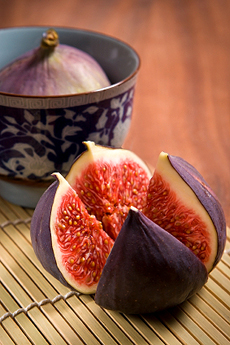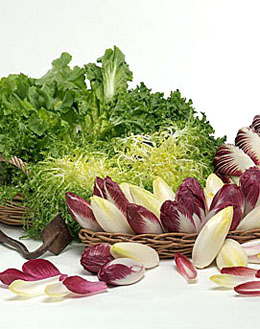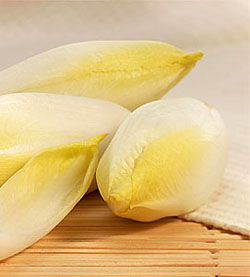

Figs, one of the first crops cultivated by man, are delightful in salads with special greens like endive. Chop them up and toss them in! Photo by Ekaterina Shlikhunova | IST.
November 2007
Last Updated April 2013
|
 |
Product Reviews / Main Nibbles / Vegetables
Recipe: Belgian Endive Salad With Roquefort, Figs & Walnut Oil
A Beautiful Salad For Fall & Winter
This is one of our favorite salads, thanks to the addition of fresh figs. We often find that the green fig varieties are even more delicious than the more ubiquitous Black Mission and Brown Turkey figs—but they don’t contrast as nicely in a green salad with white cheese.
When there’s no fresh fruit, this salad is still exciting with dry fruit. The recipe comes from Ann Klein of PlanetPomegranate.com. If there are those who don’t like fig, substitute sliced pear.
In preparing the recipe, you have an artistic judgment to make.
- You can serve the endive leaves whole on a plate with the figs, cheese and walnuts scattered on top (we like to arrange them in a star pattern—in which case you’ll need to match leaf sizes from the different endives). You can pour the dressing on top prior to serving, or let guests help themselves.
- You can tear or cut the endive into bite-size pieces for a chopped salad effect. If you cut the endives, use a ceramic knife so the edges don’t brown, or cut them shortly before serving.
- You can make a composed salad, called salade composée in French, where the ingredients are arranged separately (but artistically) on individual serving plates with a ramekin of dressing and the guests mix them together and add the dressing.
When shopping for the ingredients, you also have to know the difference between Belgian endive and the other two endives, which won’t work well with this preparation. Here, you’ll want Belgian endive or white endive, the most elegant-looking and least bitter of the endives.
Types Of Endive
There are three types of endive, and depending on which type you grew up with, it can get confusing. They are three of the many members of the chicory family, which also includes frisée and radicchio.
Belgian endive (on-DEEV, called chicory in the U.K.) grows in tight, pointed, lettuce-like heads with yellowy-white pale leaves that grow to yellow-green tips. The leaves are paper-thin. Belgian endive has a slightly bitter taste, but is the least bitter of the endives. There is also a red variety, a hybrid of endive and treviso, that has the shape of endive with the coloring of radicchio. Belgian endive was accidentally discovered by a Belgian farmer in 1830 (where it is known as witloof, white leaf). At the time, chicory roots were used as a coffee substitute. The farmer had stored the roots in his cellar; over time, they sprouted white leaves. Red endive is a cross, made 15 years ago, between Belgian endive and treviso, a red Italian chicory similar in shape to the hearts of romaine. |
|

Photo from top: escarole, curly endive, white and red Belgian endive. Photo courtesy of California Vegetable Specialties, Endive.com. |
Curly endive (EN-dive) grows in loose heads—the pencil-thin leaves have pale green bases that grow out to lacy, medium-green tips. Curly endive looks like the cousin of frisée and is frequently mistaken for chicory.
Escarole is bright green in color, with wide leaves that have curly edges. It is also bitter but more mild than curly endive.
Now, you’re better armed in selecting the “right” endive for your recipes, since many recipes are not specific.
Endive Salad Recipe
Serves 4 to 6 as a salad course.
Ingredients
- 6 medium Belgian endives
- 7 ounces Roquefort cheese,
crumbled
- 2 fresh figs (or dried), chopped
- ½ cup chopped walnuts (toast
walnuts if desired)
- ½ cup walnut oil
- ¼ cup balsamic vinegar
- 1 tablespoon honey
Preparation |
|

Photo courtesy of California Vegetable Specialties, Endive.com. |
-
CUT off the core of the endive and separate the leaves. Either tear or chop the endives into one serving bowl, or plate the whole leaves individually on 4 to 6 salad plates.
- ADD the Roquefort, figs and walnut pieces. If plated individually, arrange the items artistically. You can also plate a salade composée with separate piles of chopped endive, figs and nuts, a pile of crumbled Roquefort and a ramekin of dressing. Each guest will mix the ingredients on his or her plate with the dressing (or nibble at them separately).
- COMBINE the walnut oil, balsamic vinegar and honey and whisk well. If using a serving bowl, pour over the salad ingredients and toss gently. Otherwise, pour into a pitcher or individual ramekins for serving.
- DIVIDE the salad among 4-6 plates and serve.
Lifestyle Direct, Inc. All rights reserved. Images are the copyright of their respective owners.

|






